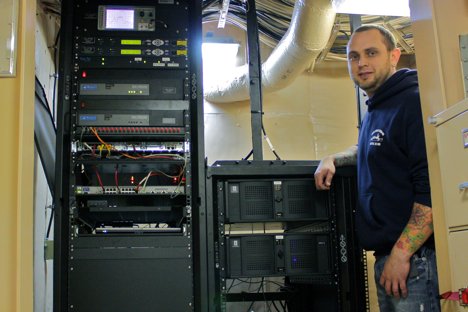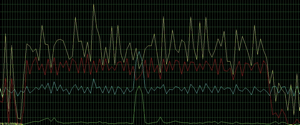July 7, 2011
Sailors of the past century, or even decade, might scratch their heads in wonder if they could have seen us on June 25 pulling away from Dutch Harbor on the Healy. Half-noticing the final sightings of land, we clung to cell phones for a bittersweet last call to loved ones.
 |
 |
||
 |
 |
Cell phones may have gone silent, but considering that we’re pushing deeper into the Arctic Ocean — today at 74 degrees N — we’re considerably well connected.
From our personal laptops, we can send and receive e-mail files under 3 MB. Any message below 200 K is automatically routed through a system called reachback. The system uses four SIM cards and, just like a cell phone, calls up SIM cards on shore to communicate the information. Reachback is practical, but not functional for much other than e-mail.
“I’m so much more productive out here without Internet all of the time,” said a scientist who asked to remain anonymous.
Internet is available, however, at series of shared desktop computers connected by a satellite system called VSAT.

Dome-shaped antenna structures on the Healy receive signal from satellites to provide an Internet while cruising in the Arctic Ocean. Credit: NASA/Kathryn Hansen
How does VSAT work? Two massive dome-shaped antenna structures sit on top of the port and starboard sides of the Healy, in sight (usually) of at least one of two satellites. Control units on the ship’s bridge are used to switch between the antennas depending on which receives the better signal. With two antennas, two antenna control units, and two modems, the system is redundant and reliable.
Problems can arise, however, when the ship sails further north. Right now, we’re picking up satellite signal that’s just 7 feet above the horizon. Sail much further north and the Earth’s curvature will soon put that signal below the ocean.

Donny Graham stands next to the VSAT control units on the bridge of the Healy. Credit: NASA/Kathryn Hansen
“We’re not going to lose VSAT on this cruise, but on other cruises we start to lose it at a latitude of about 76 degrees N, and definitely by 78 degrees N,” said Donny Graham, a network technician for Coast Guard ships and currently on the Healy.
 Graham also keeps watch over the bandwidth, which is metered (right) to ensure uninterrupted operation.
Graham also keeps watch over the bandwidth, which is metered (right) to ensure uninterrupted operation.
The bandwidth is 256 Kbit per second with up to 512 Kbit bursts. Most 3G smart phones have a faster bandwidth speed on paper, according to Graham.
“But since we manage what goes out over the Internet here, the Web surfing experience is much better then it use to be,” Graham said.
Still, the connectivity has its limitations. Computers on board refused to shake hands with the NASA chat client on shore. Instead, on July 11 at 1 p.m. EDT, experts on the ship will be answering questions via twitter from @NASA_ICE. Tweet your question about the mission at any time with hashtag #ICESCAPE.

Ship Position at 2011/07/05 18:13:40
Long: 168 16.748 W Lat: 73 9.929

We are a lot of people following the situation in the Arctic Sea, and of course we are watching Healy too. Now that you reached the ice covered part of the area, is there a possibility you could supply this blog with data of the ice thickness you surrounded by?
Best regards Espen Olsen
Is the blue ice in the Healy bridge photos old ice and the grey ice first year ice? In your blogs, can you mention how thick the ice you are working is? How thick ice is Healy rated for? Do you see Polar Bears where you currently are?
Good luck with your research.
Thanks for your excellent blogs. It is the next best thing to being on the Healy, and it has certainly kept me intouch with my daughter Shanique and the wonderful research you are all doing out there in the Artic Ocean.
Great job!
ICESCAPE @ Espen Olsen: Thank you for your question! Yes, after ice station days we can describe the sea ice thickness over the floe. As we headed north completing our first three ice stations, the sea ice became thicker: Station 1 averaged 0.76 meters thick; Station 2 averaged 1.03 meters thick; Station 3 averaged 1.20 meters thick.
ICESCAPE @ Michael Sweet: 1) Yes, grey areas in the photos tend to be thinner first-year ice, and blue areas tend to be thicker multiyear ice. There’s always the chance, however, that a patch of blue ice could actually be piled up first-year ice. 2) Regarding ice thickness, see our reply to Espen Olsen. 3) The Healy is rated to break 4.5 feet of ice at 3 knots, and 8 feet backing and ramming (though we can break more, it just takes a lot more time). 4) Yes, it’s always exciting to see polar bears! During the second ice station we watched a bear — far off in the distance — hunting for seals. The Coast Guard has precautionary measures in place to mitigate risk and keep scientists on the ice safe from bears.